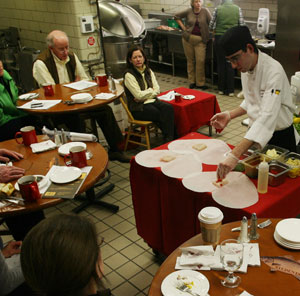Fish Story
 |
| It’s all in the presentation: Chef Nathan Todd gives trustee spouses some tips on how to prepare and present a fish dinner. |
When the Board of Trustees meets on campus, there’s a program of activities for spouses. Last winter, the theme was “Fish.”
It all started when Bill Bruett '66 happened to mention to Lynn Fox that he liked to fly fish. She asked if he would take the lead on a two-day program that would address fishing and fish, and things went swimmingly from there.
And how did they celebrate fish for two days? Here’s a round-up of activities and other touches:
-Thematic artwork hung at MacAllaster House.
-Biology Professor Brad Baldwin's Animal Biodiversity class, featuring Kira Krumhansl '06 speaking about her experiences tagging great white sharks and tuna for studies aimed at contributing to biological sustainability.
-A fly fishing demonstration by Bruett and Baldwin, including brief talks on the life span of mayflies and Baldwin's work with his classes in the field, and concluding with Bruett and crew coach Nick Hughes showing all how to cast when fly fishing (whether they caught anything, inside Newell Field House in February, has not been recorded).
-A cooking demonstration by dining services staff, showing how to clean fish and cook five recipes, which everyone got to sample. Dining services used the theme as their entry for an annual contest run by the National Association of Colleges & University Food Services.
-A traditional (almost) shore dinner, minus the shore.
The fishing demonstration covered such topics trout habitat and feeding habits (the latter because “fly fishing is all about presenting an artificial fly to a trout that mimics the aquatic insect the trout is focused on at a particular point in time,” according to the leaders’ handout); equipment (as with any hobby that looks simple at the outset, there’s a lot of it); and the importance “to humans, fish and insect life” of clean water. “We spent time discussing the Pollution Tolerance Index, a measure of water quality based on the presence of different types of aquatic insects,” says Bruett, adding that New York State water quality declined from 1992 through 2002 after a 20-year period of improvement.
“The program was well received thanks to the integration” of several types of activities, from academic to culinary, Bruett says. He suggests that the main take-away was the interrelationship of insect life, water quality and “the complexities of fly fishing. Most thought it was only about casting, which is similar to thinking hockey is only about skating,” he says.
Bruett offers special praise for the dining services staff, in particular Harlan Lowry, Nathan Todd and Kathy Dupray. “The ‘fishy’ environment Kathy and her team created in the Eben Holden kitchen area was remarkable,” he explains. “We felt like we were in a wilderness setting complete with camouflage, fishing equipment, stuffed and carved birds and fish, and even the recorded sounds of birds. The display of raw fish on ice looked like a fancy magazine layout. But, the cooking demonstration was the real treat. Harley did a terrific job describing how SLU sources its food and how every effort is made to be environmentally conscious in the purchase, preparation, serving and disposal of all foods, including of course the fish. Nathan would have made the great chefs of France weep with envy.”
Proving that his interests are not limited to freshwater species, Baldwin later presented a faculty Forum on “Rethinking Seafood” (“Do the health benefits outweigh the risks? Are we consuming endangered species, and should we care? Are seafoods marketed accurately and can consumers trust labels?”).
Landing not just any old fish but ideally a brook trout is the goal of fly fishers, and Nick Karas ’59 has established himself as an authority on that species. According to the dust jacket of his 458-page Brook Trout (The Lyons Press, rev. ed. 2002), Karas “is the author of a dozen books for sportsmen. A trained ichthyologist, as well as journalist, (he) was an outdoors columnist for New York Newsday and contributes to the New York Times.” The book “is a thorough look at the history, biology, and angling possibilities of the … brookie,” the dust jacket continues. “Few places in North America are as synonymous with brook trout fishing as the Adirondacks,” says Karas, who lives on Long Island, in introducing a lengthy chapter on St. Lawrence’s contiguous region. --NSB



